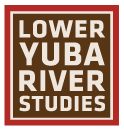Water Quality
Introduction
Water quality relates to the biological materials and chemical compounds dissolved in water and carried by water as particulate matter. A few general studies of water quality have been done for the lower Yuba River. The biggest concern has always been the large amounts of mercury imported to the Yuba catchment and used to process gold-bearing rocks, introducing a serious toxic compound into the system. Studies have been done to assess the scope of the problem, including the risk of methylation, which makes inorganic mercury bioavailable.
Past Water Quality Studies
- Beak Consultants, Inc (1989) evaluated the LYR’s water quality (dissolve oxygen, pH, dissolved solids, hardness, alkalinity, nutrients, ammonia, inorganic trace elements, select organic compounds, and turbidity, and found that it was “quite good” and within the acceptable range for salmonids. They did consistently detect mercury in sediments and fish tissue samples.
- May et al. (2000) documented significant bioaccumulation of methylmercury in fish in Lake Englebright.
- Hunerlach et al. (2004) characterized total mercury and methylmercury in sediments trapped behind Daguerre Point Dam. Higher concentrations of total mercury were found with finer sediment sizes, but total mercury concentrations were relatively low, as were methylmercury concentrations. They also assayed trace elements other than mercury using ICP-Mass Spectrometry (ICP-MS) and major elements (Ca, Mg, Na, K, Si, Fe, and Mn) by ICP-Atomic Emission Spectroscopy (ICP-AES).
- Alpers et al. (2006) reported geochemical data for mercury, methylmercury, and other constituents in the sediment under Englebright Lake. Related those to sediment particle size distributions.
- James et al. (2009) reported geochemical data for total mercury in sedimentary strata associated with hydraulic mining debris near Marysville, CA.
Bibliography
- Beak Consultants, Inc. 1989. Yuba River Fisheries Investigations, 1986-88, Summary Report Of Technical Studies On The Lower Yuba River, California.
- Hunerlach, M.P., Alpers, C.N., Marvin-DiPasquale, M., Taylor, H.E., and De Wild, J.F., 2004, Geochemistry of mercury and other trace elements in fluvial tailings upstream of Daguerre Point Dam, Yuba River, California, August 2001: U.S. Geological Survey Scientific Investigations Report 2004-5165, 66 p.
- James, L.A., Singer, M.B., Ghoshal, S., and Megison, M., 2009, Historical channel changes in the lower Yuba and Feather Rivers, California: Long-term effects of contrasting river-management strategies, in James, L.A., Rathburn, S.L., and Whittecar, G.R., eds., Management and Restoration of Fluvial Systems with Broad Historical Changes and Human Impacts: Geological Society of America Special Paper 451, p. 57–81, doi: 10.1130/2008.2451(04).
- May, J.T., Hothem, R.L., Alpers, C.N., and Law, M.A., 2000, Mercury bioaccumulation in fish in a region affected by historic gold mining: The South Yuba River, Deer Creek, and Bear River Watersheds, California, 1999: U.S. Geological Survey Open File Report 00-367, 30 p., also available at http://ca.water.usgs.gov/archive/reports/ofr00367/index.html.
